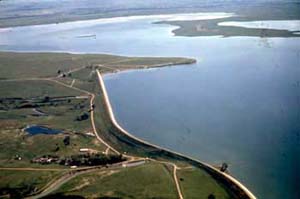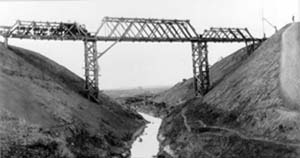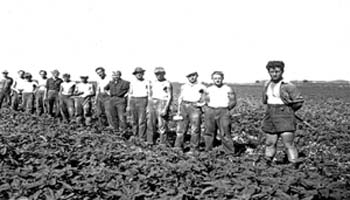
On June 28, 1897, the Sundance Kid and four other outlaws robbed the Butte County Bank in Belle Fourche, South Dakota. They made off with only $87 and ended up getting captured in the botched robbery, which turned into a comedy of errors. In those Old West days, Belle Fourche (pronounced Bell FOOSH) was shipping 2,500 carloads of cattle every month, making it the agricultural center of the Tri State area of northwestern South Dakota, northeastern Wyoming, and southeastern Montana and, apparently, an attractive target for would-be bank robbers.
While large ranches and railroad corporations dominated the aptly named Butte County in the 1890s, farmers also called Belle Fourche home. Even before construction began in 1905 on Belle Fourche Dam--at the time the largest rolled earthfill dam in the world--local companies had built small irrigation works to divert water from the nearby Redwater and Belle Fourche rivers. The “beautiful forks” (or Belle Fourche in French) of the two rivers seemed a prime spot for a dam when Congress passed the Reclamation Act of 1902, which committed the Federal Government to build irrigation works--dams, canals, and reservoirs--in 16 arid and semi-arid states in the West, including South Dakota. The citizens of Butte County wasted no time; they recommended their beautiful forks to the Secretary of the Interior, and by July 1903, engineers with the brand new U.S. Reclamation Service began investigating the Belle Fourche River watershed for irrigation works.
The Belle Fourche, a tributary of the Cheyenne River, rises in northeastern Wyoming and flows past Devils Tower National Monument before turning abruptly southeast as it crosses the border into South Dakota. The river flows past the town of Belle Fourche, population 4,600, and around the northern side of the Black Hills before joining the Cheyenne River 50 miles from Rapid City. In February 1904, Reclamation surveys estimated that 90,000 acres could be irrigated from the river’s flow--73,000 acres on the north side of the Belle Fourche and 17,000 acres on the south side. On May 10, 1904, the Belle Fourche Project received the go-ahead, and within the month, area residents formed the Belle Fourche Valley Water Users’ Association to negotiate a repayment contract with the Federal Government.

Plans were laid for a 122-foot-high earthfill dam to store water from the Belle Fourche River--even though the dam was built, not on the Belle Fourche, but across one of its tributaries, Owl Creek. A second smaller dam, a diversion dam, was built on the Belle Fourche, upriver from Owl Creek and about 1.5 miles from the town of Belle Fourche. A 6.5-mile canal, the Inlet Canal, would convey water from the diversion dam to the reservoir behind Belle Fourche Dam. A construction contract for the storage dam, known locally as "Orman Dam," was awarded on November 15, 1905, to Orman and Crook Construction Company of Pueblo, Colorado. Work began on March 1, 1906.
The Belle Fourche Project, the second project undertaken by the new U.S. Reclamation Service (now the Bureau of Reclamation), was fraught with troubles and provides an excellent example, as Christopher J. McCune writes, “of the difficulties Reclamation encountered in trying to make the arid lands of the American West ‘blossom as the rose.’” At the same time, however, many of the design details and construction procedures developed at Belle Fourche still are used by Reclamation engineers, making Belle Fourche, Richard Lyman Wiltshire writes, “a truly amazing and unique early embankment dam.” Not only was Belle Fourche one of the highest embankment dams in the world, but it stood over a mile long at 6,262 feet. In 1977, Belle Fourche Dam was listed on the National Register of Historic Places and, in 1988, it was designated a National Historic Civil Engineering Landmark.
Its troubles, however, were great in its early days. During a slumping agricultural economy in the 1920s, for instance, several farms were abandoned, while other would-be farmers didn’t have the cash necessary to settle on an irrigated Reclamation farm, which required the water user to pay a share of the project costs. Some former Black Hills miners who settled on Reclamation lands managed well, but a great many others were lawyers, doctors, or clerks who lacked farming experience or treated farming as a pastime. Land speculation, where someone bought the land but did not develop it, also plagued the project. As farms failed or passed into the ownership of non-residents, Belle Fourche plaugued Reclamation.
The nature of the land also was troublesome. South of the Belle Fourche River the soil is a thirsty, sandy loam, which proved good for sugar beets. But north of the river the land is mostly sticky clay “gumbo” that retains water, meaning the soil needs time to dry out. In these early Reclamation years, lack of knowledge about irrigation led to overwatering and drainage problems. By 1914, irrigation no longer was possible on 1,500 acres of the project and, by 1921, 4,000 acres were waterlogged and in need of drainage.
In constructing the Belle Fourche embankment, local gumbo clay was obtained from nearby borrow pits. When steam rollers tried to compact the embankment, the gumbo was so sticky that it stuck to the rollers, leading the contractor to bring in 18- and 21-ton steam-powered traction engines with widened rear wheels to finish the job. When Belle Fourche Reservoir began to fill in the summer of 1910, a strata of disintegrated shale and gravel caused seepage that required a new drainage system, which, Wiltshire writes, “has been monitored ever since, and constitutes the longest continuous monitoring performed on one of Reclamation’s embankment dams.”
Other construction issues centered on finances. In early 1908 work on the dam stopped and the contract with Orman and Crook was suspended because the Colorado company went into bankruptcy. Colorado Governor Alva Adams came to the company’s defense, writing to President Theodore Roosevelt and blaming the nation’s new law creating an eight-hour workday. Laborers on the dam, working 10 hours a day, up and left when other employers offered the shorter day. A new contract through the National Surety Company, which had guaranteed completion of the work by Orman and Crook, was let to the Hayes Brothers Company of Janesville, Wisconsin. The dam was completed on June 30, 1911, at a total cost of about $1.3 million.
Concrete panels placed on the upstream face of the dam proved a concern even before the dam was complete. Because the nearest rock quarry was 32 miles away and the quality of the sandstone considered poor, engineers used eight-inch-thick concrete panels, measuring up to 6 ½ feet and weighing about 3,000 pounds to protect the face of the dam. Cast about five miles from the construction site, the panels were transported to the dam by a narrow gauge railroad--four slabs per car--placed on a bed of gravel and hammered into place on the embankment. Belle Fourche was still a year from completion when inspectors noticed the panels were crumbling badly in places, the result of wave action exacerbated by sustained high winds. Displacement occurred virtually every year and then, in 1928, cracks three inches wide and up to 12 feet deep were discovered in the embankment. Then, in 1931, part of the upstream slope slumped during a fairly rapid drawdown of the reservoir during a drought.

Reclamation reconstructed the embankment, conducted a laboratory investigation of the embankment material and finally, in 1939, constructed an earthfill berm, covered with riprap, to improve stability of the lower portion of the dam's upstream face. Much of this work was done by young men of the Depression-era Civilian Conservation Corps, who lived at Camp Fruitdale below the south end of the massive dam. As Christine Pfaff writes, the CCC enrollees conducted a variety of activities on the Belle Fourche Project, including teaching farmers how to grow strawberry clover and brome grass, valuable pasture crops that fit the landscape.
The CCC vacated Camp Fruitdale in 1942, and between 1944 and 1946, the War Department used the camp to house German prisoners of war who were captured in 1943 in North Africa and Anzio, Italy, and in 1944 at Normandy. The German soldiers provided labor to local farmers. In 1976-77 the second phase of dam modification constructed a berm that covered and stabilized the upper portion of the dam's upstream face and a new, grass-lined spillway was constructed. Today, Belle Fourche plays an important role in western South Dakota agriculture, providing irrigation for 57,000 acres on which alfalfa, barley, oats, and forage are raised; testament to the region’s cattle industry heritage.
Visit the National Park Service Travel Bureau of Reclamation's Historic Water Projects to learn more about dams and powerplants.
Last updated: January 13, 2017
